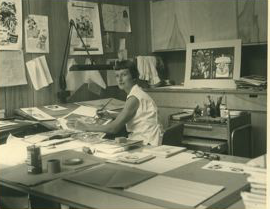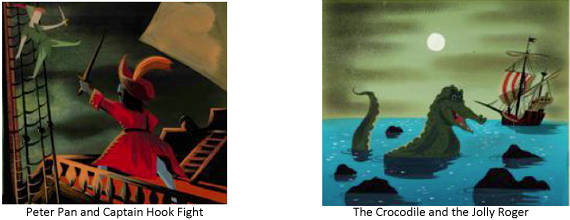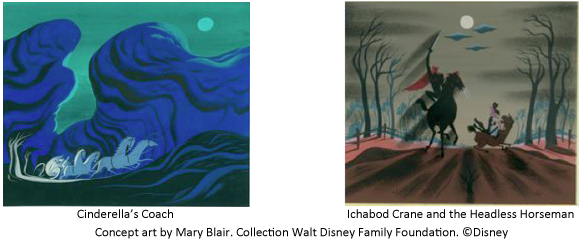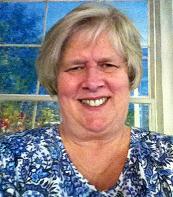 I am so lucky! I was one of the attendees in the sold-out audience for the The Art and Flair of Mary Blair. Author and lecturer John Canemaker presented a host of drawings and film snippets of Mary’s work, strung together with a colorful palette of words. Canemaker described her work as flat and stylized and polar opposites of reality, while her painting displayed a simplicity that conjures up Grandma Moses. The other artists at the Studio didn’t like her artwork, not being able to understand why so much attention was paid to her. They wanted dimension and were frightened by her austerity and angular shapes. As he progressed through the first series of images, he described her work with visually descriptive words like “conjurer of color,” “sorceress of style,” and “princess of pattern.”
I am so lucky! I was one of the attendees in the sold-out audience for the The Art and Flair of Mary Blair. Author and lecturer John Canemaker presented a host of drawings and film snippets of Mary’s work, strung together with a colorful palette of words. Canemaker described her work as flat and stylized and polar opposites of reality, while her painting displayed a simplicity that conjures up Grandma Moses. The other artists at the Studio didn’t like her artwork, not being able to understand why so much attention was paid to her. They wanted dimension and were frightened by her austerity and angular shapes. As he progressed through the first series of images, he described her work with visually descriptive words like “conjurer of color,” “sorceress of style,” and “princess of pattern.”
Mary Blair was born in McAlister, Oklahoma. Later the family moved to Morgan Hill, California (What a surprise for this San Jose native to hear since Morgan Hill is right next door!). It was fun to see her art, beginning with the design of a Trojan pattern for the Cannon Towel Company art contest she won, to the drawings for the “Baby Ballet” that was to be part of the proposed second installment of Fantasia. (Too bad that sequel wasn’t made.)
Mary and her husband, Lee Blair, also an artist, traveled with Walt to South America. John showed us a treasure trove of her paintings from that trip. Brilliant colors lay on a background of black. Her artwork can be seen in the movie The Three Caballeros. Her three big movies were Cinderella in 1950, Alice in Wonderland in 1951, and Peter Pan in 1953. She also painted for the movies Johnny Appleseed (a segment of the 1948 feature Melody Time), So Dear to My Heart, and The Adventures of Ichabod and Mr. Toad.

Mary left Disney in 1953 to freelance. She worked again with Walt on it’s a small world for the 1964-1965 New York World's Fair. She created her designs by using collages of wallpaper clippings, plastic wrap, and acrylics. When the attraction was brought to Disneyland in 1965, she created the distinctive kinetic facade and clock tower. Her next adventure with Walt was designing and creating the murals for Disneyland's Tomorrowland made of ceramic tiles. She also created a special ceramic tile mural for Walt, as a gift for the pediatric waiting room at the Jules Stein Eye Institute at UCLA.
There were many fun facts about Mary. She designed her own clothes. She was left-handed. She painted with watercolor and gouache. She wasn’t afraid of color. She was intuitive but self-assured. She loved children, which is so evident in the multitude of paintings of children. Walt Disney loved her art. The lecture was so packed with information the audience wished John could continue. Infused with humor, John was a great presenter and often, when he stated a fact about Mary or Walt, his face lit up and said, “of course you know this…look whom I’m talking to.” Everyone laughed in appreciation. Thank you to The Walt Disney Family Museum for making these events possible for all of us that love to learn, hear, and experience the history of everything Disney.
[Images above: 1) Alice and the Cheshire Cat, concept art by Mary Blair. Collection Walt Disney Family Foundation. ©Disney. 2) Mary Blair at work in her studio. Photo by Lee Blair.]



Gail Neufeld
Volunteer at The Walt Disney Family Museum
